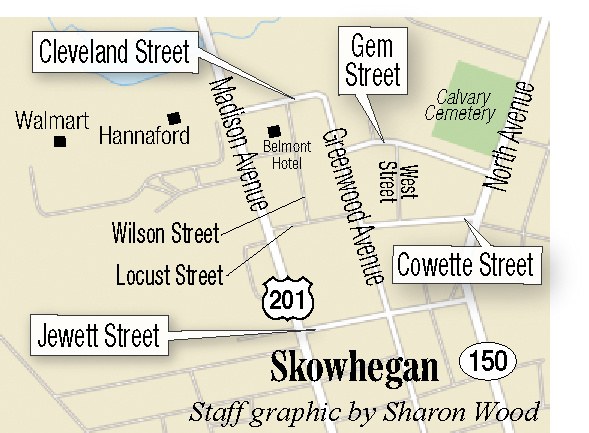SKOWHEGAN — Selectmen on Tuesday night postponed a vote on whether to adopt a townwide “Traffic Calming Policy” for public participation in alleviating traffic problems, saying the town needs more time to look at the policy before a May 23 public hearing on the issue of town streets.
Selectwoman Darla Pickett pointed out that most towns have a committee doing the work that Road Commissioner Greg Dore has done in developing the policy. Selectman Soren Siren agreed, noting the written policy, which he said is a good policy, should be posted on the town website. He said the lesson learned in a recent debate over changing town streets is that time should be taken to examine the big picture.
The Planning Board also should be given copies of the written proposed policy, selectmen agreed.
No action will be taken on adopting the policy until after the May 23 public hearing, the board said in a unanimous 5-0 vote.
Under the proposed policy, 10 or more residents from any given area of town could file a petition with the town clerk for review of their traffic complaints. The petition then would be sent to the road commissioner and each selectman. Any member of the Board of Selectmen also could initiate the process. The road commissioner would analyze the complaint and report back to the selectmen with his findings for final action by them.
Dore said the policy presented to selectmen Tuesday night is based on the model policy for traffic calming in the city of Portland.
“Traffic calming comes typically in a neighborhood of speeding car, traffic volume and truck traffic,” Dore said before Tuesday’s meeting. “It’s a procedure that the citizens of Skowhegan can follow to implement traffic calming.”
The policy comes as a result of complaints in April of high traffic volume and speeding cars on Gem Street and Cowette Street and associated problems where they meet Greenwood Avenue and Cleveland Street, next to the Belmont Motel and across from the Hannaford supermarket — from Madison Avenue to North Avenue.
Drivers were using those streets as a shortcut to get across town. The area also includes West Street, Locust Street and Wilson Street, and it is a residential subdivision, not meant to be a shortcut across town, officials have said. Gem Street and Cowette Street were made one-way from Madison Avenue, but that soon changed, when one-way street signs were taken down. Traffic was not allowed to enter either Gem Street or Cowette Street from North Avenue. “Do not enter” signs remain in place on Cowette Street only.
New signs were installed recently announcing “No thru traffic — locals only.”
Dore said drivers going south on Madison Avenue from the transfer station or from Cornville and Athens still must go around from Jewett Street to enter the neighborhood, but once a driver is inside the area, the streets are open to two-way traffic.
With the traffic calming policy in place, there would be a process for resident input and a road map to get to a solution, Dore said.
He said his analysis of the petition complaint will determine whether the problem qualifies for action by the town.
“Do they really have a problem?” he said of the final analysis. “A lot of time the people can misrepresent an issue because they’re not there all day.”
The analysis will be based on traffic volume, speed, residential density and the number of children living on the street. Dore said his department did a traffic count and found that 11,449 cars and light trucks used Gem Street in both directions over the course of one week to get to one side of town or the other. He said 34 percent of those drivers were exceeding the speed limit. About 5,500 cars were counted on Cowette Street that week.
Dore said future steps in the policy would include methods to be used for traffic calming — speed tables, stop sign locations, one-way streets, turning-traffic or entry-prohibited signs and other signs designating the neighborhood as residential and small business, to be used only by people who live or visit there.
The target, he said, is cut-through traffic.
After 45 days of the new traffic pattern being in place, a meeting would take place with the neighborhood. Invitations to attend the meeting would be the responsibility of the people who initiated the petition, he said.
“At this meeting they have to approve the plan. They need 60 percent of the base number of people to approve it,” Dore said. “Then it goes to the selectmen. The selectmen are the only ones that can implement traffic control.”
After the plan is in place for six months, 10 or more residents or business owners or any selectman could file a written petition to modify it. Also, if the road commissioner were to find the new plan to be a hazard to public health, he could dissolve it, with approval by the selectmen.
Doug Harlow — 612-2367
Twitter:@Doug_Harlow
Send questions/comments to the editors.




Success. Please wait for the page to reload. If the page does not reload within 5 seconds, please refresh the page.
Enter your email and password to access comments.
Hi, to comment on stories you must . This profile is in addition to your subscription and website login.
Already have a commenting profile? .
Invalid username/password.
Please check your email to confirm and complete your registration.
Only subscribers are eligible to post comments. Please subscribe or login first for digital access. Here’s why.
Use the form below to reset your password. When you've submitted your account email, we will send an email with a reset code.